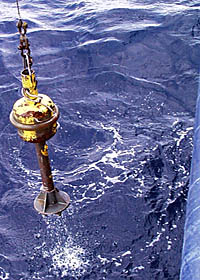|
|
TODAY'S WEATHER
The rock corer, nicknamed "Mighty Mo", is hauled on board after another successful sampling run to the seafloor.
April 8, 2000 By Dr. Dan Fornari We have now collected samples of lava from the East Pacific Rise axis over a distance of about 20 nautical miles or 37 kilometers. Only once out of thirteen lowerings did the seafloor refuse to give us some glass. That was when we sent the corer down to an old volcanic peak off the ridge axis. We suspect that the volcanic rock may have been covered by sediment so the corer was unable to collect the glassy lava underneath. Mike Perfit and the students have been busy melting the wax and extracting the glassy lava. They are carefully labeling the samples and packing them away to take home to their laboratory for chemical analysis. That will help them figure out how young and old lavas are related to each other, and where and how the molten rocks were produced deep in the Earth’s mantle. Last night, we were working on deck, and some of the lights were shining on the water. This attracted many fish -- Mahi mahi, tuna, and several large white tip sharks! The sharks were beautiful to watch, gliding gracefully through the water, with their bodies slowly swaying back and forth. Several times, they darted off, probably chasing a midnight snack of tuna or Mahi mahi! Tonight the “featured attraction” in the ocean aquarium is large squid chasing flying fish under a crescent moon. We have decided to put Argo II down for one more survey in this area. We have been looking at the DSL-120 sonar records that we collected a few days ago, and noticed an area of seafloor that looks bumpy. How do lava flows form these bumps? Are they small volcanic cones where lava erupted? These are the questions we want to answer. By tomorrow morning, Argo II should be back on deck. We will recover the transponders, do a few more rock cores, and then head south to look for a 3 year old lava flow that the Autonomous Hydrophone Array detected in June of 1997. Come with us as we head towards the Equator!
|
|||||||||||||||||||||||||||||||||||||||||||||||||||||||||||||||||||||||||||||||||||||||||||||||||||||||||||||||||||||||||||||||||||||||||||||||||||||||||||||||||||
© 2010 Dive and Discover™. Dive and Discover™ is a registered trademark of
Woods
Hole Oceanographic Institution




